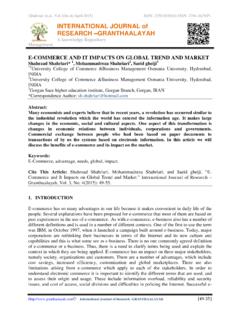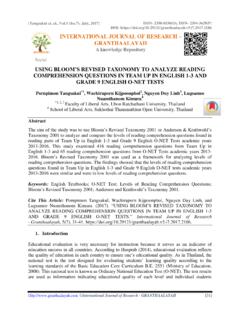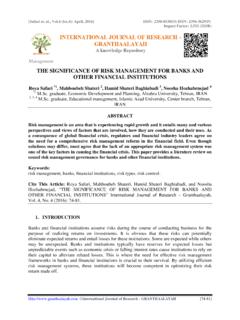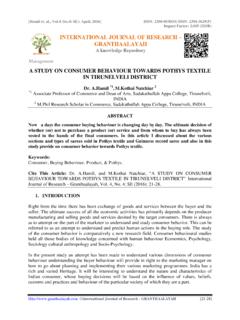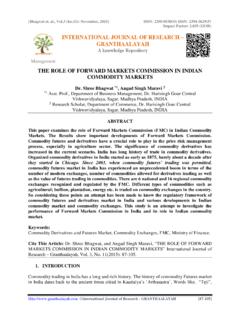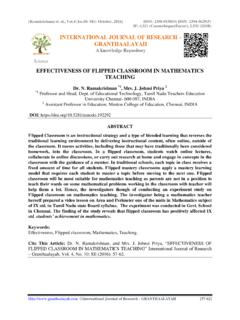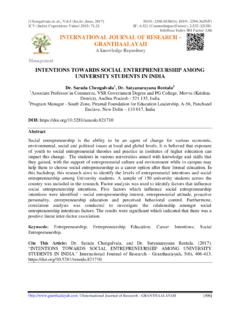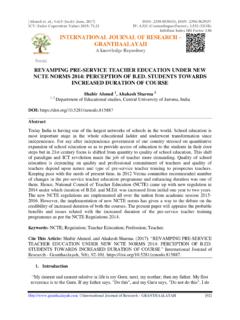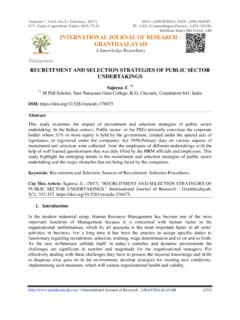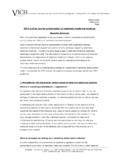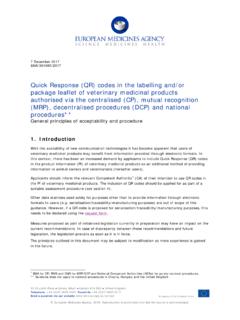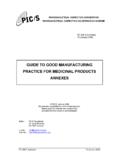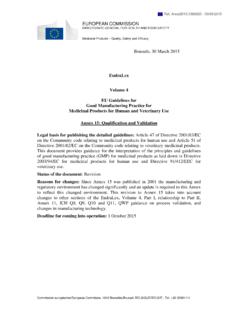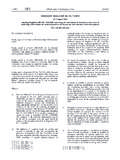Transcription of REVIEW ON TRADITIONAL ETHNO-VETERINARY MEDICINE …
1 [Oyda *, ( ): August, 2017] ISSN- 2350-0530(O), ISSN- 2394-3629(P) DOI: International Journal of Research - GRANTHAALAYAH [109] Science REVIEW ON TRADITIONAL ETHNO-VETERINARY MEDICINE AND MEDICINAL PLANTS USED BY INDIGENOUS PEOPLE IN ETHIOPIA: PRACTICE AND APPLICATION SYSTEM Semayat Oyda *1 *1 Department of Livestock and Fishery husbandry, Dawuro zone, Southern Ethiopia, Ethiopia Abstract The objective of the REVIEW paper was to highlight indigenous practice to TRADITIONAL veterinary MEDICINE and medicinal plants used by indigenous people. TRADITIONAL MEDICINE has been defined as the sum total of all knowledge and practices whether explicable or not, used in the diagnosis, prevention and elimination of physicals, mental or social imbalances which passes from generation to generation, whether verbally or in writing.
2 The application of TRADITIONAL MEDICINE to veterinary MEDICINE has been termed as ethnoveterinary MEDICINE . In Ethiopia up to 80% of the population uses TRADITIONAL MEDICINE due to the cultural acceptability of healers and local pharmacopeias, the relatively low cost of TRADITIONAL MEDICINE and difficult access to modern health facilities. Some of medicinal plants were Monopsis Sellariodes, solanium anguivi Lam, Vigina spp, Nicotiana tabacum L, Argemone Mexicana L, and Platostoma Rotundifolium etc. and they useful for different diseases. TRADITIONAL practitioners include bone setters, birth attendants, tooth extractors, (called yetirs awolaki, 'Wogesha' and yelimd awalaj' respectively in Amharic) herbalists, as well as 'debtera', 'tenquay' (witch doctors), and spiritual healers such as 'weqaby' and 'kalicha'. Healing in Ethiopian TRADITIONAL MEDICINE is not only concerned with curing of diseases but also with the protection and promotion of human physical, spiritual, social, mental and material wellbeing.
3 Drugs were administered using different routes, the main ones being, topical, oral and respiratory and are stored usually in containers such as bottles, papers, pieces of cloth, leaves and horns, and were kept anywhere at home. Keywords: Ethnoveterinary; MEDICINE ; Plant; Tradition; Healers; Indigenous. Cite This Article: Semayat Oyda. (2017). REVIEW ON TRADITIONAL ETHNO-VETERINARY MEDICINE AND MEDICINAL PLANTS USED BY INDIGENOUS PEOPLE IN ETHIOPIA: PRACTICE AND APPLICATION SYSTEM. International Journal of Research - Granthaalayah, 5(8), 109-119. 1. Introduction TRADITIONAL MEDICINE in Ethiopia has been widely used by various ethnic groups, about 90% of livestock population depends on TRADITIONAL MEDICINE and most of it comes from plants (Endashaw, 2007; Atinafu et al., 2017). [Oyda *, ( ): August, 2017] ISSN- 2350-0530(O), ISSN- 2394-3629(P) DOI: International Journal of Research - GRANTHAALAYAH [110] Ethnoveterinary MEDICINE , the scientific term for TRADITIONAL animal health care, provides low-cost alternatives to allopathic drugs.
4 Research into ethnoveterinary MEDICINE is often undertaken as part of a community-based approach that serves to improve animal health and provide basic veterinary services in rural areas (Shical et al., 2010). In addition to its focus on botanicals, ethnoveterinary MEDICINE covers people s knowledge, skills, methods, practices, and beliefs about the care of their animals (Maine VAC, 2009). Ethnoveterinary MEDICINE is frequently used for treating animal as well as human diseases by many different people around the world. According to the World Health Organization, at least 80% of people in developing countries depend largely on indigenous practices for the control and treatment of various diseases affecting both human beings and their animals (WHO, 2002). Ethnoveterinary MEDICINE provides valuable alternatives to and complements western-style veterinary MEDICINE .
5 Ethnoveterinary remedies are accessible and easy to prepare and administer, at little or no cost to the farmer (Jabbar et al., 2005) In many poor rural areas, ethnoveterinary MEDICINE can play an important role in animal production and livelihood development, and often becomes the only available means for farmers treat ill animals (Tamboura et al., 2000, Jabbar et al., 2005, Shical et al., 2010). Therefore, the objective this paper is to highlight indigenous practice to TRADITIONAL veterinary MEDICINE in local community people and REVIEW the medicinal plants used by indigenous people. 2. Definition of Some Phrases or Words TRADITIONAL MEDICINE has been defined by the world health organization (WHO,2008) as the sum total of all knowledge and practices whether explicable or not, used in the diagnosis, prevention and elimination of physicals, mental or social imbalances and relying exclusively on practical experience and observation handed down from generation to generation, whether verbally or in writing.
6 This system of health care is also known as folk MEDICINE , ethno MEDICINE , or indigenous MEDICINE (Belay, 2016). TRADITIONAL (Indigenous) means something which is communicated from ancestors to descending; only by oral means. Thus the knowledge of TRADITIONAL MEDICINE both for man and animal is handed down from one generation to another through practical demonstrations or through oral communications. Ever since the life started on the earth, diseases and death coexisted with him and with their animals. Therefore efforts have been made to get relief out of it by using herbs in various forms as MEDICINE from the very beginning of human civilization (Belay, 2016; Kathmandu, 1991). The World Health Organization (WHO) defines TRADITIONAL MEDICINE as health practices, approaches, knowledge and beliefs incorporating plant, animal and mineral based medicines, spiritual therapies, manual techniques and exercises, applied singularly or in combination to treat, diagnose and prevent illnesses and maintain well-being (WHO, 2001).
7 The world health organization (WHO) (2001) defined TRADITIONAL MEDICINE as the total combination of knowledge and practices that can be formally explained or used in prevention and elimination of physical, mental or social imbalance and relying exclusively on practical experience and observation handed down from generation to generation, whether verbally or in writing (Fassil, 2001). [Oyda *, ( ): August, 2017] ISSN- 2350-0530(O), ISSN- 2394-3629(P) DOI: International Journal of Research - GRANTHAALAYAH [111] TRADITIONAL MEDICINE is mainly concerned with folk beliefs, knowledge, skills, methods and practices which are used in the healthcare of animals. The knowledge varies from region to region, and from community to community (Fassil, 2001). In general, ethnoveterinary practices have been developed by trial and error and by actual experimentation (Asayegn and Abiy, 2009).
8 Ethnoveterinary MEDICINE comprises of TRADITIONAL surgical techniques, TRADITIONAL immunization, magico-religious practices, and the use of herbal medicines to treat livestock diseases (Tafesse and Mekonnen, 2001; Fekadu, 2010; Yibrah, 2015). Ethoveterinary MEDICINE provides TRADITIONAL medicines, which are locally available and usually cheaper than standard treatments. Livestock holders can prepare and use homemade remedies with minimum expense. So far, many livestock holders in rural areas where there are relatively few veterinarians and shortages of other facilities, TRADITIONAL medicinal plants are the only choice to treat many ailments (McCorkle, 1995). 3. TRADITIONAL Ethno veterinary in Ethiopia TRADITIONAL veterinary healthcare has enormous potential; however, this potential has not yet been exploited at the national level (Tilahun and Giday, 2007).
9 Recently, serious attempts have been made by the Institute of Biodiversity Conservation and Research (IBCR) on scientific research to develop medicinal plants for three major livestock diseases. The major diseases identified by the Institute were tapeworm infestation, mastitis and dematophilosis (Fekadu, 2010). In Ethiopia as well as in most developing countries, animal disease remains one of the principal causes of poor livestock performance, leading to an ever increasing gap between the supply of, and the demand for, livestock products (Sori et al., 2004). In Ethiopia, livestock production directly constitutes important (Yeneayehu and Girma, 2017). TRADITIONAL MEDICINE has maintained its popularity in all regions of the developing world and its use is rapidly spreading in the industrialized countries. WHO estimates that in several African countries TRADITIONAL birth attendants assist in a majority of births (WHO, 2002).
10 In Ethiopia up to 80% of the population uses TRADITIONAL MEDICINE due to the cultural acceptability of healers and local pharmacopeias, the relatively low cost of TRADITIONAL MEDICINE and difficult access to modern health facilities. In 2000 only of all deliveries in Ethiopia were attended by trained attendants and health workers. The rest were attended by TRADITIONAL birth attendants or relatives (Kebede et al., 2006). ETHNO-VETERINARY MEDICINE (EVM) is a scientific term for TRADITIONAL animal health care that encompasses the knowledge, skills, methods, practices, and beliefs about animal health care found among community members (McCorke, 1996). According to Misra and Kumar (2004), EVM is the community-based local or indigenous knowledge and methods of caring for, healing and managing livestock. This also includes social practices and the ways in which livestock are incorporated into farming systems.
